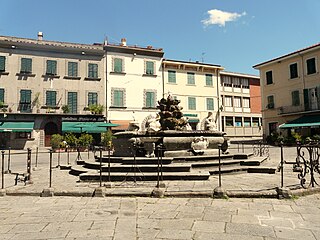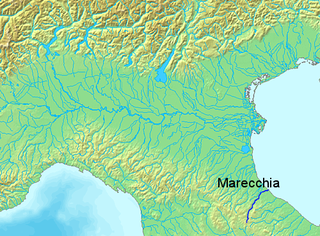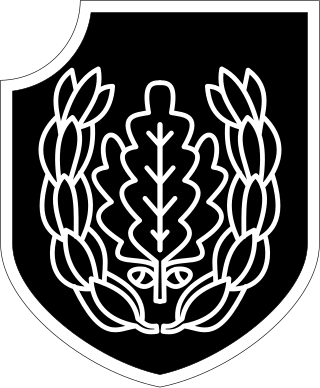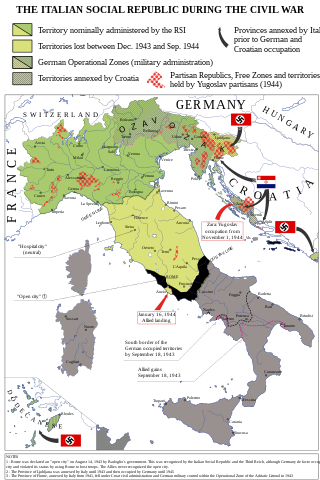Related Research Articles

Fivizzano is a comune in the province of Massa and Carrara, Tuscany, central Italy.

The Marecchia is a river in eastern Italy, flowing from near Monte dei Frati in the province of Arezzo, Tuscany, to the Adriatic Sea in Rimini, Emilia-Romagna. Along its course, the river passes next to or near the settlements of Novafeltria, Verucchio, and Santarcangelo di Romagna. It passes near the Republic of San Marino. Among its tributaries are the San Marino river and the Ausa.

The governments of the German Empire and Nazi Germany ordered, organized, and condoned a substantial number of war crimes, first in the Herero and Namaqua genocide and then in the First and Second World Wars. The most notable of these is the Holocaust, in which millions of European Jewish, Polish, and Romani people were systematically abused, deported, and murdered. Millions of civilians and prisoners of war also died as a result of German abuses, mistreatment, and deliberate starvation policies in those two conflicts. Much of the evidence was deliberately destroyed by the perpetrators, such as in Sonderaktion 1005, in an attempt to conceal their crimes.
Casteldelci is a comune (municipality) in the province of Rimini, in the Italian region of Emilia-Romagna, located about 140 kilometres (87 mi) southeast of Bologna and about 55 kilometres (34 mi) south of Rimini.

The 16th SS Panzergrenadier Division "Reichsführer-SS" was a motorised infantry formation in the Waffen-SS of Nazi Germany during World War II.

The Palazzo Cesi-Gaddi war crimes archive or armoire of shame is a wooden cabinet discovered in 1994 inside a large storage room in Palazzo Cesi-Gaddi, Rome which, at the time, housed the chancellery of the military attorney's office. The cabinet contained an archive of 695 files documenting war crimes perpetrated on Italian soil under fascist rule and during Nazi occupation after the 8 September 1943 armistice between Italy and Allied armed forces. The actions described in the records spanned several years and took place in various areas of the country, from the southern city of Acerra to the northern province of Trieste and as far east as the Balkans; it remains unclear, to this day, how the archive remained concealed for so long, and who gave the order to hide the files in the immediate post-war period.

114th Jäger Division was a light infantry division of the German Army in World War II. It was formed in April 1943, following the reorganization and redesignation of the 714th Infantry Division. The 714th Division had been formed in May 1941, and transferred to Yugoslavia to conduct anti-partisan and Internal security operations. It was involved in Operation Delphin which was an anti-partisan operation in Croatia that took place between 15 November and 1 December 1943. The objective of the mission was to destroy the Partisan elements on the Dalmatian islands off central Dalmatia.

The 65th Infantry Division was a German division in World War II. It was formed in July 1942.

Polizeiregiment "Südtirol", later Bozen, and finally SS-Polizeiregiment "Bozen", was a military unit of the German Ordnungspolizei recruited in the largely ethnic-German Alto Adige region in north-east Italy in late 1943, during the de facto German annexation of the region. The ranks were ethnically German Italian draftees while officers and NCOs were Germans.
The following events occurred in April 1944:
The 362nd Infantry Division was an infantry division of the German Army during the Second World War, active from 1943 to 1945. Formed in Italy, it participated in the Italian Campaign for the entire duration of its war service. It was implicated in the massacre of 97 civilians in what is known as the Benedicta massacre, which occurred at Piedmont in April 1944.

The Memorial Centre Lipa Remembers is a museum commemorating the killing of 269 civilians - mostly elderly, women and children - in April 1944 in Lipa, Croatia. The massacre was perpetrated by the German military, together with Italian and Chetnik collaborationist forces.
The awards for Civil Valor are the honors the Italian Republic grants in order to "reward acts of exceptional courage that clearly manifest civic virtue and to recognize the recipients as worthy of public honor". Individual citizens can receive the award, and it can also be bestowed collectively on all members of a military department or all residents of a municipality, city, or province when they have knowingly exposed their life to manifest danger.

Two of the three major Axis powers of World War II—Nazi Germany and their Fascist Italian allies—committed war crimes in the Kingdom of Italy.

Giovanni Remo Fornasini was an Italian Roman Catholic priest, resistance member and patriot in Bologna. He was murdered by a German Nazi Waffen SS soldier and was posthumously awarded Italy's Gold Medal of Military Valour. He is being investigated by the Catholic Church towards his possible canonisation. His beatification was celebrated in Bologna on 26 September 2021.
The Vinca massacre was a massacre carried out near Fivizzano, Tuscany, by the German 16th SS Panzergrenadier Division from 24 to 27 August 1944 in which 162 Italian civilians were killed.
The San Terenzo Monti massacre, sometimes also referred to as the Bardine massacre or Bardine San Terenzo massacre, was a massacre carried out near Fivizzano, Tuscany, by the German 16th SS Panzergrenadier Division from 17 to 19 August 1944 in which 159 Italian civilians were killed.

The Fragheto massacre was the massacre of 30 Italian civilians and 15 partisans in Fragheto, a frazione of Casteldelci in central-northern Italy, on 7 April 1944, during World War II, by soldiers of the German 356th Infantry Division. After partisans belonging to the Eighth Garibaldi Brigade ambushed troops approaching the hamlet, fourteen soldiers of the Sturmbattaillon OB Sudwest conducted house-to-house searches and summarily killed civilians. Representing 40% of the hamlet's population, many of the victims were elderly people, women, or children. A further seven partisans and one civilian were shot the next day at Ponte Carrattoni, at the confluence of the Senatello and Marecchia.
References
- ↑ "Massacres with more than 100 victims". Atlas of Nazi and Fascist Massacres in Italy (in Italian). Retrieved 21 August 2018.
- ↑ Kellerhoff, Sven Felix (7 January 2008). "Fünf SS-Verbrecher werden angeklagt" [Five SS criminals put on trial]. Die Welt (in German). Retrieved 27 September 2018.
- ↑ "Bundesgerichtshof Urt. v. 17.03.1970, Az.: 5 StR 218/69" [German High Court verdict from 17 March 1970] (in German). 17 March 1970. Retrieved 27 September 2018.
- ↑ "BOVES, 19.09.1943" (in Italian). Atlas of Nazi and Fascist Massacres in Italy. Retrieved 24 September 2018.
- ↑ "Monte Carmignano, Caiazzo, 13.10.1943" (in Italian). Atlas of Nazi and Fascist Massacres in Italy. Retrieved 23 September 2018.
- ↑ "Pazin (Pisino), 04.10.1943". Atlas of Nazi and Fascist Massacres in Italy (in Italian). Retrieved 21 August 2018.
- ↑ "PIETRANSIERI ROCCARASO 21.11.1943". Atlas of Nazi and Fascist Massacres in Italy (in Italian). Retrieved 21 August 2018.
- ↑ "MONCHIO SUSANO E COSTRIGNANO PALAGANO 18.03.1944". Atlas of Nazi and Fascist Massacres in Italy (in Italian). Retrieved 21 August 2018.
- ↑ "FOSSE ARDEATINE ROMA 24.03.1944". Atlas of Nazi and Fascist Massacres in Italy (in Italian). Retrieved 21 August 2018.
- ↑ Brennan, J. G.; Green, L. C. (1997). ""The Case of General Dostler"". Naval War College Review. 50 (4): 115–117. ISSN 0028-1484. JSTOR 44638781.
- 1 2 3 "7 aprile 1944 – 80 anni fa la strage di Fragheto" [7 April 1944 – 80 years ago, the Fragheto massacre]. Chiamami Città (in Italian). 6 April 2024. Retrieved 7 April 2024.
- ↑ "Eccidio di Fragheto: Rimini presente alla commemorazione a 74 anni dalla strage" [Fragheto massacre: Rimini present at the commemoration 74 years after the massacre]. Comune di Rimini. 7 April 2024. Retrieved 7 April 2024.
- ↑ "Strage di Fragheto" [Fragheto massacre]. Paesaggi della memoria (in Italian). Retrieved 7 April 2024.
- ↑ Susini, Daniele. "Episodio di Ponte 8 Martiri (Ponte Carrattoni), Rimini, 08.04.1944" [Case of the Eight Martyrs Bridge (Carrattoni Bridge), Rimini, 08.04.1944](PDF). straginazifasciste.it (in Italian). Retrieved 7 April 2024.
- ↑ "VALLUCCIOLE PRATOVECCHIO STIA 13.04.1944". Atlas of Nazi and Fascist Massacres in Italy (in Italian). Retrieved 21 August 2018.
- ↑ "Lipa (Lipa), Elsane, Bistrica (Bisterza) 30.04.1944". Atlas of Nazi and Fascist Massacres in Italy (in Italian). Retrieved 21 August 2018.
- ↑ "CIVITELLA IN VAL DI CHIANA 29.06.1944". Atlas of Nazi and Fascist Massacres in Italy (in Italian). Retrieved 21 August 2018.
- ↑ "CAVRIGLIA 04.07.1944". Atlas of Nazi and Fascist Massacres in Italy (in Italian). Retrieved 21 August 2018.
- ↑ "SANT'ANNA DI STAZZEMA 12.08.1944". Atlas of Nazi and Fascist Massacres in Italy (in Italian). Retrieved 21 August 2018.
- ↑ "SAN TERENZO MONTI FIVIZZANO 17-19.08.1944". Atlas of Nazi and Fascist Massacres in Italy (in Italian). Retrieved 21 August 2018.
- ↑ "The responsible". L'Eccidio del Padule di Fucecchio. Retrieved 12 August 2018.
- ↑ "VINCA FIVIZZANO 24-27.08.1944". Atlas of Nazi and Fascist Massacres in Italy (in Italian). Retrieved 21 August 2018.
- ↑ "SAN LEONARDO AL FRIGIDO MASSA 16.09.1944". Atlas of Nazi and Fascist Massacres in Italy (in Italian). Retrieved 21 August 2018.
- ↑ "Monte Sole (scheda generale)". Atlas of Nazi and Fascist Massacres in Italy (in Italian). Retrieved 21 August 2018.
- ↑ "San Martino di Lupari, 29.4.1945". Atlas of Nazi and Fascist Massacres in Italy (in Italian). Retrieved 21 August 2018.